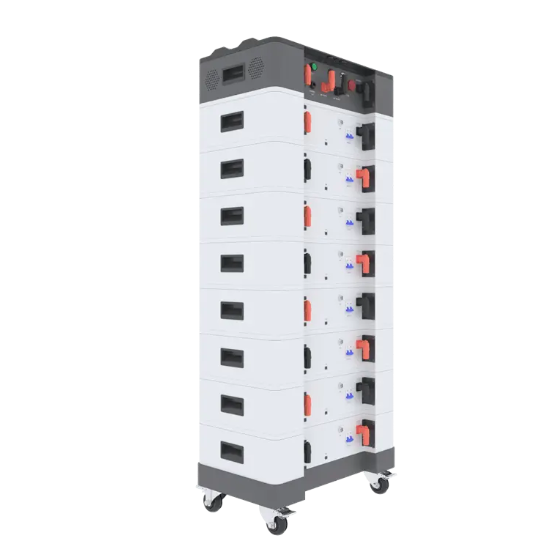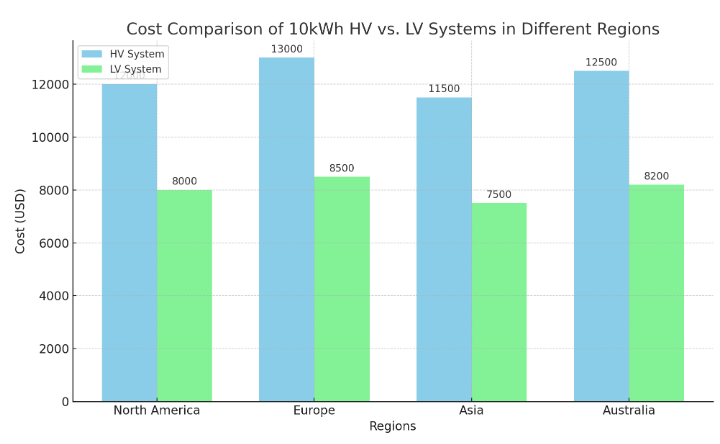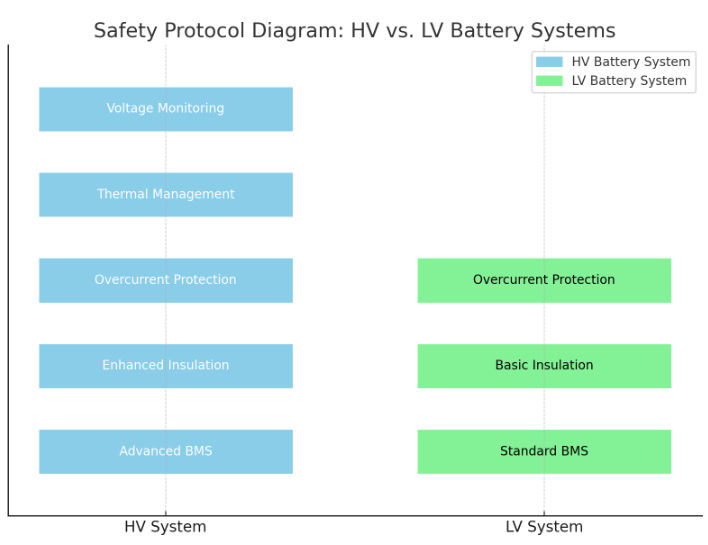HV Battery vs. LV Battery: Which Suits Your Power System? Lithium battery play a crucial role in modern technology, powering everything from smartphones to solar energy systems. When it comes to lithium solar batteries, they are generally categorized into two types: high voltage battery(HV Battery) and low voltage battery (LV Battery) . For users with appliances requiring 400V or 48V power, understanding the difference between HV and LV batteries can significantly impact their power system choices.
Understanding the advantages and limitations of each battery type is key. While high voltage systems may pose risks of circuit damage, low voltage systems might affect overall performance. Recognizing these differences helps provide a clearer understanding of their operational principles and best-use scenarios.

Kamada Power High Voltage Battery
What is Voltage?
Voltage, measured in volts (V), represents the electric potential difference between two points in a circuit. It is similar to water pressure in a pipe: it drives the flow of electric current through a conductor, much like water flows through a pipe.
Higher voltage in a circuit pushes electric charges more forcefully, allowing for more effective energy transfer. This is particularly relevant in battery systems, where different voltage levels can greatly influence performance.
What is an HV Battery?
An HV battery, or high voltage battery, operates at voltage levels typically ranging from 100V to 600V or higher. These batteries are designed for applications requiring higher voltage, which helps reduce current levels and minimizes energy losses during charge and discharge cycles. This results in a more efficient and responsive energy storage system, particularly beneficial for large-scale applications.
Pro Insight: Modern electric vehicles (EVs) often use HV battery systems with voltages ranging from 400V to 800V, enabling rapid acceleration and extended driving ranges.
What is an LV Battery?
An LV battery, or low voltage battery, typically operates at voltage levels from 2V to 48V. These batteries are characterized by their lower voltage, making them suitable for smaller applications such as portable electronics, small-scale solar systems, and automotive auxiliary power supplies.
Example: A standard 12V lead-acid battery used in traditional internal combustion engine vehicles is a classic LV battery, providing power to the starter motor and electronic accessories.
Choosing Between HV and LV Battery for Your Application
Scenario-Based Analysis:
- Residential Solar Systems: For small residential solar setups, an LV battery may be preferred due to its safety and simplicity. For larger installations, however, an HV battery is often more efficient and cost-effective in the long run.
- Commercial Energy Storage: In commercial setups, especially those involving grid-scale energy storage, HV batteries are typically the better choice due to their ability to handle large power loads efficiently.
- Electric Vehicles: HV batteries are essential for EVs, enabling faster charging, longer driving ranges, and better performance compared to LV batteries, which might not meet the power demands of modern EVs.
Decision Matrix: High Voltage Battery vs. Low Voltage Battery
| Scenario |
Power Requirement |
Efficiency Needs |
Safety Concerns |
Optimal Choice |
| Residential Solar System |
Medium |
Medium |
High |
LV Battery |
| Electric Vehicle |
High |
High |
Medium |
HV Battery |
| Grid-Scale Energy Storage |
High |
Very High |
Very High |
HV Battery |
| Portable Electronics |
Low |
Low |
Medium |
LV Battery |
| Industrial Equipment |
High |
High |
High |
HV Battery |
| Off-Grid Installations |
Medium |
Medium |
High |
LV Battery |
Differences Between LV and HV Batteries
Energy Output Power
HV batteries generally provide higher energy output compared to LV batteries. This is due to the relationship between power (P), voltage (V), and current (I), as described by the equation P = VI.
Example: For a power output of 10kW, a 400V HV battery system requires a current of 25A (P = 10,000W / 400V), whereas a 48V LV system needs approximately 208A (P = 10,000W / 48V). The higher current in the LV system leads to greater resistive losses, reducing overall efficiency.
Efficiency
HV batteries enhance efficiency by maintaining constant power with lower current, thus minimizing resistive losses.
Case Study: In a solar installation, a 200V HV battery shows about 15% less energy loss during transmission compared to a 24V LV battery, making it more efficient for large setups.
Charging and Discharging Rates
HV batteries support higher charging and discharging rates, making them ideal for applications requiring rapid energy transfer, such as electric vehicles or grid stabilization.
Data Insight: A 400V HV battery system in an EV can be charged to 80% in under 30 minutes with a fast charger, while an LV system may require several hours to achieve the same charge level.
Initial Investment and Installation Costs
HV batteries typically have higher initial costs due to advanced technology and safety measures. However, the long-term efficiency gains and potential energy savings often outweigh these upfront expenses, especially in large-scale installations.
Cost Comparison Chart: A chart comparing the initial cost of installing a 10kWh HV battery system versus an LV battery system in different regions illustrates the differences in equipment, installation, and 10-year maintenance costs across North America, Europe, Asia, and Australia.

Safety Concerns
HV batteries, due to their higher voltage, pose greater risks of electrical shock and require more sophisticated safety measures, including advanced Battery Management Systems (BMS) and enhanced insulation.
Safety Protocol Diagram: This diagram contrasts the safety protocols for HV and LV battery systems, showing the advanced protection required for HV systems, such as enhanced insulation and thermal management.

Limited Availability
HV batteries may face supply chain challenges, particularly in regions with less developed infrastructure for high-voltage systems. This limitation can impact the adoption of HV batteries in some areas.
Certainly! Here’s a more detailed and enriched version of the content on high voltage (HV) and low voltage (LV) batteries, based on a deep understanding of their advantages and applications.
Advantages and Applications of High Voltage Battery
Advantages of HV Batteries
- Efficient Power Transmission: High voltage batteries excel in applications where long-distance power transfer is required. Higher voltage levels reduce the amount of current needed for a given power output, which minimizes energy loss due to resistive heating in conductors. For instance, HV batteries are used in large-scale solar farms and wind farms where efficient transmission to the grid is crucial. The reduced current also leads to lower voltage drops over long distances, making HV systems more effective in maintaining stable power delivery.
- High Power Requirements: HV batteries are designed to meet the demands of high-power applications. Electric vehicles (EVs), for example, require substantial power to achieve rapid acceleration and high top speeds. HV batteries provide the necessary energy density and power output to meet these requirements, enabling EVs to deliver superior performance compared to those using LV batteries. Similarly, grid-scale energy storage systems rely on HV batteries to store and dispatch large quantities of electricity efficiently.
- Enhanced EV Performance: Modern electric vehicles benefit significantly from HV batteries, which support faster charging times and longer driving ranges. High voltage systems enable rapid energy transfer during charging, reducing downtime and enhancing the convenience of EVs. Additionally, HV batteries support higher power outputs, which is essential for advanced driving features like quick acceleration and high-speed performance.
Applications Where HV Batteries Excel
- Grid-Scale Energy Storage: HV batteries are ideal for grid-scale energy storage systems, where large volumes of electricity need to be stored and distributed with high efficiency. Their ability to handle high power loads and maintain efficiency over extended periods makes them suitable for balancing supply and demand on the electrical grid, integrating renewable energy sources, and providing backup power during outages.
- Electric Vehicles: In the automotive industry, HV batteries are essential for optimizing the performance of electric vehicles. They not only provide the power needed for high-speed travel but also contribute to the efficiency of regenerative braking systems, which recover energy during braking and extend driving range.
- Commercial and Industrial Energy Systems: For commercial and industrial applications that require large-scale energy storage, HV batteries offer a reliable and efficient solution. These systems are used in data centers, manufacturing plants, and large commercial buildings to ensure uninterrupted power supply, manage peak load demands, and support critical operations.
Advantages and Applications of Low Voltage Battery
Advantages of LV Battery
- Safety and Simplicity: LV batteries are preferred in applications where safety and ease of use are paramount. Lower voltage levels reduce the risk of electrical shock and make the design and implementation of battery systems simpler and more straightforward. This makes LV batteries suitable for consumer electronics and residential energy systems where user safety is a top priority.
- Space and Weight Considerations: LV batteries are advantageous in applications with strict space or weight constraints. Their compact size and lower weight make them ideal for portable devices, small residential energy systems, and applications where minimizing the physical footprint is important. For example, in portable electronics like smartphones and laptops, LV batteries provide the necessary power while maintaining a slim and lightweight form factor.
Applications Where LV Battery Are Preferred
- Small Residential Energy Storage: In small residential energy storage systems, LV batteries offer a balance of safety, simplicity, and cost-effectiveness. They are often used in conjunction with home solar panels to store excess energy for later use, providing homeowners with a reliable backup power source and reducing dependence on the grid.
- Portable Electronic Devices: LV batteries are the go-to choice for portable electronics due to their compact size and ability to deliver adequate power. They are used in devices such as smartphones, tablets, and portable chargers, where space is limited, and battery performance needs to be optimized for frequent recharging and extended usage.
- Off-Grid Installations with Moderate Energy Demands: For off-grid applications with moderate energy requirements, such as remote cabins or small-scale solar power systems, LV batteries are practical and cost-effective. They provide a reliable power source in locations without access to the main electrical grid and can be scaled to meet varying energy needs.
Conclusion
Choosing between high voltage battery(HV Battery) and low voltage battery(LV battery) depends on your specific needs and application requirements. HV batteries excel in scenarios requiring high power and efficiency, such as electric vehicles and large-scale energy storage. Conversely, LV batteries are ideal for smaller, more portable applications where safety, simplicity, and space are critical. By understanding the advantages, efficiencies, and ideal use cases for each type, you can make a well-informed decision that meets your energy needs and system requirements.